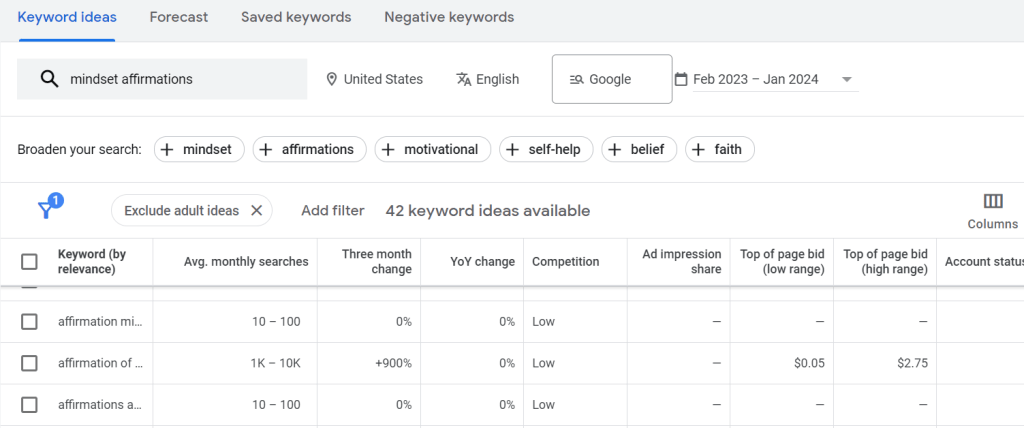Keyword research is a critical component of search engine optimization (SEO). By identifying and targeting the right keywords, you can improve your website’s visibility, drive organic traffic, and ultimately boost your online presence. There are some key steps and strategies to conduct effective keyword research for SEO.

By following these tips and examples, you’ll be on your way to attracting increased monthly searches using the keyword research process. Use keywords suggestions on your blog posts, products, images and website for higher search engine rankings.
The Power of Keyword Research Tools:
Keyword research tools are indispensable in the realm of SEO. You have a lot of options for the best keyword research tools. These tools not only help in identifying relevant keywords but also provide insights into search trends, competition levels, and user search intent. You can gain new keyword ideas, or keyword phrases on any specific topic but also determine the most effective keywords. This crucial data enables you to tailor your content strategy and is the easiest way to increase search engine results.
You can also use Keyword Tools to find great ideas for products.
Key Features to Look For:
- Search Volume Data: This shows how often a keyword is searched. High-volume keywords indicate popular topics but might have high competition.
- Keyword Difficulty/SERP Analysis: Understanding how competitive a keyword is helps in assessing if it’s feasible to rank for it.
- Related Keywords and Suggestions: Good tools suggest variations and related terms, expanding your potential keyword pool.
- Long-Tail Keyword Discovery: Long-tail keywords, often less competitive, can be goldmines for niche topics.
- Trend Analysis: It’s essential to know if a keyword is gaining or losing popularity over time.
Use Keyword Research Tools:
Utilizing keyword research tools can simplify the process and provide valuable insights. There are several powerful tools available, both free and paid, that can help you discover relevant keywords, assess their search volume, and analyze competition.
Popular Keyword Research Tools:
- Google Keyword Planner: A classic tool, integrated with Google Ads, offering deep insights into search volumes and competition. It is free, but in order to use it you need a Google Ads account.
- SEMrush: Known for its comprehensive features including keyword analytics, site audits, and competitor analysis. Pricing is $129 a month.
- Ahrefs: Includes a best links filter as well as AI suggestions. Pricing starts at $99 a month. There is a free version with limited options.
- Moz Keyword Explorer: Provides unique metrics like Keyword Difficulty and Organic CTR estimates. And there is the option to add AI features but starts at $99 month.
- Ubersuggest: A user-friendly tool great for beginners, offering keyword suggestions, SERP analysis, and more. 1 website and 150 daily searches for $29 a month.
- Keysearch: Easy to use tool at a reasonable cost. 200 daily credits for $17
Here are some tools that are not as well known and some have great features:
- Soovie: Limited but has great suggestions for search terms, free
- Topic Ranker: For SEO beginners, put in your website and it will give new keywords for your niche. For $9 a month you get 3 searches, basic level is $59 a month.
- Jaaxy: More keywords than you can imagine. And you can track your website, see which activities are bringing more traffic. You can get 30 keyword searches and then $49 a month.
- Keywordtool.io: Not even a free trial, $69 a month but you can get keywords by platform, YouTube, Pinterest, Google, Etsy, Instagram.
- SECockpit: Advertised for SEO professionals because of the depth of information. Number of tools and amount of information is overwhelming. The starter plan is $39 a month, cheaper if you pay for a year at once. Includes 10 keyword searches a day.
Note: If you have an Etsy shop, there are specific keyword search tools for that shop as well to show you the best keywords for selling on Etsy.
Analyze Keyword Difficulty:
While selecting keywords, it’s essential to consider their difficulty level or competition. Keyword difficulty indicates how hard it would be to rank for a specific keyword. Tools like Ahrefs or Moz can provide a keyword difficulty score. Aim for a mix of high-volume, low-difficulty keywords along with more competitive keywords.
This way, you can target both short-term and long-term SEO goals. For instance, target a highly specific long-tail keyword with lower competition, like “gluten-free vegan dessert recipes,” along with broader keywords like “vegan dessert recipes” to capture a wider audience.
Long-Tail Keywords and User Intent:
Long-tail keywords, consisting of three or more words, are often less competitive and more targeted. They can help you align your content with user intent, increasing the chances of attracting relevant traffic. Consider the specific needs, questions, or problems your target audience might have when searching for information related to your blog post.
By incorporating long-tail keywords that address these needs, you can create content that resonates with your audience and improves your SEO. For example, if you’re writing a blog post about gardening tips, incorporate long-tail keywords like “how to grow tomatoes in small spaces” or “organic pest control for vegetable gardens.
Analyze Competitors:
Analyzing your competitors’ keyword strategy can provide valuable insights and help you discover new keyword opportunities. Identify the top-ranking competitors for your target keywords and analyze the keywords they are using. Tools like SEMrush or Ahrefs can help you find your competitors’ top-ranking keywords.
Look for gaps in their strategy, keywords they may have missed, or areas where you can provide better and more comprehensive content. By leveraging competitor analysis, you can refine your keyword research and gain a competitive edge.
Examining Keyword Volume and Difficulty
When it comes to assessing the score and volume of keywords for SEO, there are a few factors to consider. While the ideal score and volume may vary depending on your specific goals and industry, here are some general guidelines to help you gauge what is considered good in terms of keyword scores and volumes:
Keyword Score or Difficulty:
Keyword score or difficulty is a measure of how challenging it is to rank for a particular keyword. Scores are typically provided on a scale, often ranging from 0 to 100, with higher scores indicating higher competition. Here’s a breakdown of what is generally considered good:
Low Difficulty (0-30): These keywords are relatively easier to rank for and are ideal for short-term SEO goals. They typically have lower competition, allowing you to achieve quicker visibility and organic traffic gains.
Medium Difficulty (30-60): Keywords in this range have moderate competition. While they may require more effort to rank for, they often offer a balance between search volume and attainability.
High Difficulty (60-100): Keywords with high difficulty scores are highly competitive and challenging to rank for. These keywords are often dominated by well-established websites and may require a long-term SEO strategy to achieve top rankings.
When conducting keyword research, aim for a mix of low, medium, and high difficulty keywords based on your overall SEO objectives. By targeting a combination of these scores, you can gradually build your website’s authority and visibility over time.
Keyword Search Volume:
Search volume refers to the number of searches a keyword receives within a given timeframe (usually monthly). While high search volume indicates a popular keyword, it’s important to balance it with keyword relevance and competition. Here’s a general breakdown:

High Search Volume: Keywords with a high search volume (thousands or more) indicate significant interest and potential traffic. These keywords often have broader relevance and attract a larger audience. However, they also tend to have higher competition, making it more challenging to rank for them.
Medium Search Volume: Keywords with moderate search volume (hundreds to a few thousand) strike a balance between relevance and competition. These keywords can attract a decent amount of targeted traffic while being relatively less competitive.
Low Search Volume: Keywords with low search volume (tens to hundreds) are more specific and niche-oriented. While they may have lower traffic potential, they often have lower competition, making them easier to rank for. These keywords can be valuable for targeting a specific audience or long-tail queries.
When selecting keywords, aim for a mix of high, medium, and low search volume keywords based on your target audience and content goals. Consider the relevance of the keyword to your content and the balance between potential traffic and competition.

Remember that keyword research is an iterative process, and it’s essential to monitor your keyword performance over time. Regularly assess the impact of keywords on your website’s visibility, organic traffic, and conversions. Adjust your keyword strategy as needed to optimize your SEO efforts and stay ahead of your competition
Conducting effective keyword research is essential for optimizing your blog posts and improving your website’s SEO. By understanding your target audience, utilizing keyword research tools, analyzing keyword difficulty, focusing on long-tail keywords,
Also keep in mind there are trends during the year. Algorithms change and evolve and you need to review older keywords to stay relevant.